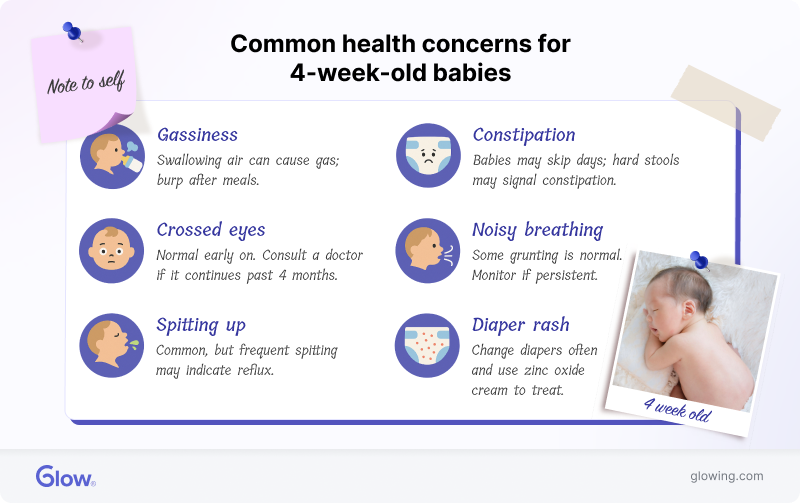Baby Month by Month
4-Week-Old Baby
Your baby can now see objects that are about a foot away.

Your 4-week-old baby is becoming more aware of the world around her. This month has been full of exciting developments, from her early smiles to increased motor skills, not to mention a whole lot of learning for both of you. Let’s see what this next week has in store for you and your baby.
Your baby’s developmental milestones at 4 weeks
At 4 weeks old, your baby is changing quickly. Here are some key things you might notice:
Physical growth
Your baby will likely grow in spurts rather than at a steady pace. During your baby’s growth spurts, she may demand more frequent feedings (this behavior is called cluster feeding). These periods usually last just a few days.
Each baby’s growth rate is different, but on average, your baby will probably gain about 1.5–2 pounds and get about 1 inch taller each month. 1 If you have any concerns about her growth rate, discuss them with her doctor at her 4-week checkup.
Sensory development
Your little one can now see objects about a foot away. 2 One of the best ways to play with your baby at this stage is to talk to her, put new objects in her field of vision, and introduce her to different textures, such as a soft toy or the skin on your nose.
Communication
While crying is still your baby’s main form of communication, you may notice more variations in her cries, with each signifying different needs. A low-pitched cry might mean she’s hungry, while a nasally cry could tell you she’s tired or uncomfortable. Over time, you’ll learn to tell the difference between her sounds.
You may even hear a few coos and begin to see those first precious smiles. Although these are likely just a reflex at this stage, it’s okay to enjoy them anyway. 3
Motor skills
Your 4-week-old baby is learning how to control her body. Her movements will still be jerky, but she may bring her hands to her mouth more often and start to move her legs more. She might even lift her head briefly and move it from side to side during tummy time.
Speaking of tummy time, it’s one of the best ways to help your baby develop her motor skills, so make sure you’re giving her plenty of regular sessions. Start with just a few minutes every day and gradually increase the length of each session as she gets stronger. 4
Your baby’s feeding and sleep patterns
While your baby probably doesn’t yet have regular eating and sleeping patterns (take a moment of silence to mourn your sleep schedule), she may start developing a loose routine and more recognizable wake windows.
Feeding
By the end of the 4th week, your baby’s feeding habits may be more predictable than they used to be. If you’re ever unsure of how much she needs to eat, let her take the lead. Watch for her hunger cues and feed her whenever she needs it.
In general, expect her to eat about 8–12 times daily, every 2–4 hours, although this can vary. 5 Formula-fed babies need to eat about 4 ounces every 4 hours. 6
Sleep
If you’re especially sleep-deprived this week, you may wonder when your baby will sleep through the night. Unfortunately, she’s not quite there yet, but she may sleep for longer stretches and stay awake for longer periods (also called wake windows), too.
Throughout the day, she’ll likely sleep about 12–16 hours in total, so don’t worry about your newborn sleeping too much, even if it seems like she spends more than half of her time snoozing. 7 That’s completely normal.
While a consistent sleep schedule is still a ways off, you can encourage healthy sleep habits by creating a bedtime routine that lets your baby know it’s time to sleep. This might include:
- Running her a warm bath
- Changing her diaper
- Giving her a massage
- Putting on fresh pajamas
- Reading her a story
- Singing her a lullaby
Above all, try to lay her down when she’s drowsy but not fully asleep to prevent her from getting overtired.

Common health concerns for a 4-week-old baby
It’s normal to worry about your baby’s health. Here are some very common challenges you and your baby might face at the 4-week mark:
- Gassiness: Don’t be surprised if you’ve got a gassy baby on your hands. Her digestive system is still immature and she may be sensitive to something in your breastfeeding diet (what you eat affects the composition of your milk somewhat). She may also swallow air as she eats, allowing gas to build up in her tummy. Gas is uncomfortable but not dangerous. Burping her after each feeding can help.
- Constipation: Both breastfed and formula-fed babies may go several days without pooping, although breastfed babies tend to poop a little more often than their formula-fed brethren. 8 It’s normal for your baby’s bowel movements to slow down as she gets older. Watch for small, hard poops, which could indicate that she’s constipated.
- Crossed eyes: Don’t be alarmed if you notice your baby crossing her eyes occasionally. It’s common at this age, but if it happens frequently or doesn’t stop by the time she’s 4 months old, talk to your pediatrician. 9
- Spitting up: Spitting up is also very common at this age. As long as your baby is gaining weight and isn’t in pain, there’s usually no cause for concern, but if she spits up excessively or seems to be in distress, she may have reflux, and you should talk to her doctor.
- Noisy breathing: Your baby’s breathing may be quite varied at this age, with pauses and noises such as grunts. This is normal and generally not a cause for concern.
- Diaper rash: The more often your baby pees and poops, the more likely she is to get one of the various types of diaper rashes. The best way to avoid a rash is to change her diaper often and keep the area clean and dry. Applying petroleum jelly to the area can also help prevent diaper rashes. If one does appear, applying a cream with zinc oxide should help. 10
- Cradle cap: Don’t get scared if you see scaly patches on your baby’s scalp. This is called cradle cap, and it’s a common issue for babies in their first year of life. Fortunately, it often goes away with a little TLC (frequent hair washing, moisturizing, and hair brushing or combing). Don’t pick those scales, though, as this can cause infection.
- Epstein pearls: You may see tiny white spots lining your baby’s gums or on the roof of her mouth. These are Epstein pearls, small cysts that many babies are born with or develop shortly after birth. While they’re usually harmless and don’t need treatment, don’t pick or rub them, as they could get infected. They’ll disappear on their own before long.
- Baby moles: Many babies are born with congenital nevi (moles) or develop them in their infancy. While they’re usually nothing to worry about, if your baby has a mole, keep an eye on it and let your doctor know if it changes in appearance or gets bigger, is asymmetrical, or has an uneven mix of colors or shades.
- Baby acne: These breakouts tend to appear on a baby’s face (cheeks, nose, and forehead), but may also pop up on your baby’s back, scalp, neck, and chest. This type of acne is usually harmless and normally resolves without treatment when a baby is between 4 and 6 months old.
As you learn more about parenting, remember that you’re the expert on your baby. Trust your instincts, and don’t hesitate to ask for help or advice when you need it.
Use your journal or baby tracker app to record anything of note you want to bring to your pediatrician’s attention. Some of the best baby trackers can condense your baby’s health info into shareable reports for your doctor.
The 4-week checkup
Even if your baby is doing perfectly fine and meeting all her milestones, she’ll still need to attend a 4-week checkup with her pediatrician.
During this well-baby visit, your baby’s doctor will perform a full physical exam to check her growth, reflexes, and overall health. They’ll also address any questions you might have about feeding, sleeping, and development.
Her pediatrician will check her height and weight and note these numbers on a growth chart to keep track of her progress. Remember that growth patterns vary, and your baby’s pediatrician is looking for any major increases or decreases that may indicate a problem, not whether your baby is perfectly average.
This is also when your baby may receive her second dose of the hepatitis B vaccine. 11
How to keep your baby safe
At the appointment, your doctor may remind you of these important safety practices:
Sleep safety
At 4 weeks old, your baby is still at risk of sudden infant death syndrome (SIDS). Also known as “crib death,” SIDS is when a baby dies for no apparent reason, often in their crib. While SIDS is understandably scary, you can employ preventative measures to keep her safe when she’s sleeping.
When it’s time to sleep, always place her on her back on a firm mattress. Before they’re 12 months old, babies can’t sleep on their stomach.
At this age, don’t let your baby sleep in her crib with:
- Blankets
- Pillows
- Toys
- Bottles
You should also keep her crib in your room, but avoid sharing the bed with your baby. 12
Fortunately, you can stop worrying about SIDS once your baby reaches 12 months old (which is about the time when babies can sleep with a pillow and the other soft materials mentioned). Her risk also drops significantly at 6 months.
Car seat safety
At 4 weeks old, your baby’s car seat should still be rear-facing. In fact, you shouldn’t turn your baby’s car seat around until she’s at least 1 year old (though experts advise keeping her rear-facing for as long as possible). 13 The best infant car seats have higher height and weight limits for the rear-facing position that let your baby stay in them for longer.
Don’t use the car seat for sleeping outside of the car, and don’t feed your baby in her car seat.
Pacifier use
Once your baby is 4 weeks old, you can give her a pacifier during naps and at bedtime to help reduce the risk of SIDS. However, limit pacifier use to a few minutes at a time for breastfeeding babies younger than 1 month. 12 Don’t put the pacifier back into your baby’s mouth once it has fallen out.
Addressing common postpartum concerns
While you’re primarily focused on your baby’s health and safety, don’t ignore your own well-being. Your body’s also changing and needs care and attention.
Here are a few common issues you may experience 4 weeks after giving birth:
- Sore nipples: If you’re breastfeeding, your nipples may become sore or cracked. You can try rubbing lanolin ointment on them or applying a cool compress to relieve any discomfort. 14 Keep nursing if you can, but switch to the less sore side if it’s too uncomfortable at first.
- Thrush: Watch for symptoms of thrush, a yeast infection that can spread between your breasts and your baby’s mouth. Reach out to your doctor if your nipples itch or burn or if you notice that the inside of your baby’s mouth is coated in a white substance. 15
- Postpartum backaches: Back pain is common when you’re caring for an infant, but you can ease it with a few simple changes. When you lift your baby, remember to bend at your knees, not your waist. Try carrying her in a sling or carrier to relieve the strain on your arms and hips.
- C-section recovery: If you had a Caesarean section, note that your C-section scar may still be healing. Follow your doctor’s instructions for cleaning your scar, and bandage the area as needed.
Remember to take time to recharge each day. It’s okay to feel overwhelmed, sleep-deprived, and unsure. Be kind to yourself and ask for help from your loved ones if you need support.
Reach out to your doctor if you feel like your mood has been unmanageable, such as if you feel an intense sadness (postpartum depression) or extreme anger (postpartum rage).
How to reconnect with your partner (if you have one)
If you have a partner, you may find it challenging to spend time with them when much of your time is devoted to caring for your baby and yourself. Having a baby can be stressful, but it’s important to put some time aside for you and your partner, even if it’s just for a few minutes each day.
Try having a date night once in a while while your baby is asleep. Whether you cook together, play a game, or simply cuddle on the couch with a movie, anything that allows you to destress and communicate is worth prioritizing.
Talking about sex
One of the things you should start talking about once your baby reaches the 4-week milestone is sex. This can be a sensitive topic.
Most doctors recommend waiting several weeks to have sex after childbirth to give your body time to heal. There’s also no need to rush. 16 You’ll also need to be extra careful about sex after a C-section.
Talk openly with your partner about how you feel, and ease back into intimacy when you’re both ready.
What to shop for this week
Hopefully, you haven’t already maxed out your credit card on diapers, clothing, and a crib. There are more items you might want to get this week:
- Baby bottles: If you’re using bottles, try a few different types to see which one your baby likes best. At this stage, she probably still needs a slow-flow nipple.
- Baby swings: A swing can be a safe place to put down your baby when you need a break, and it can help soothe her. Always use the swing in the most reclined position. Never allow your baby to sleep in it, and watch her for the entire time, never leaving her unattended.
- Sensory toys: Engage your baby’s senses with different textures to develop her ability to tell objects apart. Try items such as blankets, crinkly baby books, and sensory toys that light up or make sounds.
- Parenting books: It’s normal to have questions and feel like you don’t know what you’re doing, but there are lots of places to find help. One option is to read a research-based parenting book that offers guidance specifically for infants.
Recommended books
The following books are all recommended by the American Academy of Pediatrics (AAP):
- Caring for Your Baby and Young Child: Birth to Age 5 by Tanya Remer Altmann and David L. Hill
- Heading Home With Your Newborn by Laura A. Jana and Jennifer Shu
- Your Baby’s First Year by Steven P. Shelov
- New Mother’s Guide to Breastfeeding by Joan Younger Meek
Final thoughts
As your 4-week-old baby quickly develops, so too will your parenting skills. Taking care of a 1-month-old is no easy feat, but it’s well worth the reward of getting to know your little one more and more.
Remember to be patient, listen to your gut, and reach out for support when you need it.
Article Sources
- The Children's Hospital of Philadelphia. "The Growing Child: 1 to 3 Months" Retrieved July 16, 2025.
- MedlinePlus. "Infant - newborn development" Retrieved July 16, 2025.
- American Academy of Pediatrics. "When do babies first smile?" Retrieved July 16, 2025.
- Nemours KidsHealth. "Tummy Time" Retrieved July 16, 2025.
- U.S. Centers for Disease Control and Prevention. "How Much and How Often to Breastfeed" Retrieved July 16, 2025.
- Chicago Department of Public Health. "Feeding Basics" Retrieved July 16, 2025.
- Chicago Department of Public Health. "Infant Sleep Patterns" Retrieved July 16, 2025.
- Children’s Hospital Colorado. "Baby Poop Guide" Retrieved July 16, 2025.
- American Academy of Pediatrics. "Warning Signs of Vision Problems in Infants & Children" Retrieved July 16, 2025.
- American Academy of Dermatology Association. "How to treat diaper rash" Retrieved July 16, 2025.
- U.S. Centers for Disease Control and Prevention. "Hepatitis B Perinatal Vaccine Information" Retrieved July 16, 2025.
- MedlinePlus. "Sudden infant death syndrome" Retrieved July 16, 2025.
- U.S. Department of Transportation. "Car Seat Recommendations for Children" Retrieved July 16, 2025.
- UW Medicine. "Sore Nipples" Retrieved July 16, 2025.
- MedlinePlus. "Thrush - children and adults" Retrieved July 16, 2025.
- Penn Medicine. "News and views" Retrieved July 16, 2025.







